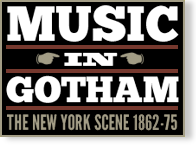Central Park Garden Concert
Event Information
Venue(s):
Central Park Garden
Proprietor / Lessee:
East 14th St at the corner of Irving Place Academy of Music
Manager / Director:
J. [manager] Gosche
Conductor(s):
Theodore Thomas [see also Thomas Orchestra]
Price: $75
Event Type:
Orchestral
Record Information
Status:
Published
Last Updated:
11 March 2025
Performance Date(s) and Time(s)
14 Aug 1873, 8:00 PMPerformers and/or Works Performed
Citations
Includes program; Mendelssohn’s Scottish symphony was performed in its entirety.
“New York, Aug. 16.—Despite the unpleasant state of the weather, several hundred people were assembled at the Central Park Garden last Thursday evening, when an unusually attractive programme was presented comprising the following numbers [see above].
The lovely Scotch Symphony is heard none too often in New York, and no music could have been more welcome to the majority of the listeners. It is safe also to assume that a better performance was never heard in this city. The complete silence and devout attention to the music which prevailed in the house doubtless were not without their effect upon the players. People who left their homes and came shivering through darkness and rain (over coats were in demand on that evening) made good listeners you may believe! and then such music as Mendelssohn wrote cannot fail to receive the best interpretation which the players can give. The evenness and delicacy of the strings in the introduction could not be surpassed, and the rich warm coloring which pervades the Allegro was so well brought to view that it seemed like a picture of the south.
The Scherzo, however, is thoroughly Scotch, and light tripping measures were so gracefully rendered that the danger of an encore seemed imminent. Mr. Thomas has, however, by a long course of training succeeded in breaking his audience of the vicious habit of spoiling a performance by a demand for the repetition of favorite parts, and, although the nuisance occasionally breaks out anew, it is promptly suppressed on its appearance.
The Andante from the B-flat trio, arranged for the orchestra, is played frequently at the garden concerts. It is so well arranged that we can forgive Liszt for having laid hands upon it, although it is a work of such surpassing beauty that to change it in the least seems like sacrilege. The harp, which in this arrangement is substituted for the piano, is of course overpowered by the strings, while in the original the piano is placed so boldly in the foreground as to make the term ‘trio’ seem like a misnomer.
So little chamber music is heard in New York that the beautiful theme of this Adagio might remain unknown to many of those who frequent the garden were it not for this arrangement, and the effect, especially if the listener is placed on the side opposite the first violin and the harp, is very good.”

